
Freitag, 25.09.
Hanseatenweg, Großes Parkett und Kleines Parkett
20:00 – 21:30 Uhr
02 Konzert: Sehnsuchtmaschine
Begrüßung: Prof. Jeanine Meerapfel, Präsidentin der Akademie der Künste.
Werke von Scherchen (DE), Gerhard (ES/UK), Katzer (DE), Grosskopf (DE) und Sannicandro (IT/FR). Matthias Bauer, Kontrabass; Ingólfur Vilhjálmsson, Klarinette; Joaquín Sáez Belmonte, Saxophon; Gregorio García Karman, Hannes Fritsch, Klangregie.
Hermann Scherchen, Achorripsis (1963), ein Klang-Lichtspiel-Studie über die gleichnamige Komposition von Iannis Xenakis, restaurierte Fassung von 2015 mit der verschollenen Tonspur, 5 min. Mit freundlicher Unterstützung des Archivs der Akademie der Künste und der Deutschen Kinemathek.
Roberto Gerhard, DNA in Reflection (1963), Experimentalfilm basierend auf dem DNS-Doppelhelix-Modell von Watson und Creek. Regie: Hans Boye und Anand Sarabhai, Laboratory of Molecular Biology, Cambridge University, 9 min.
Georg Katzer, L’homme machine / Der Maschinenmensch (1998) für Kontrabass, Live-Elektronik und Video, 22 min. Matthias Bauer, Kontrabass. (Video: Veit-Lup)
(15 Minuten Pause)
Erhard Grosskopf, DIALECTICS (1969/70) für Tonband und drei Instrumentalisten, erste Deutsche Aufführung der 7-Kanal Tonbandfassung, präsentiert im Kugelauditorium der Weltausstellung in Osaka 1970, 11 min. (Eberhard Blum, Flöte; Claude Lelong, Viola; Vinko Globokar, Posaune).
Valerio Sannicandro, Ephemeris – Ekleipsis (2015, UA) for clarinet, saxophone and live-electronics with two adjacent spaces, 27min. Kompositionsauftrag des Studios für Elektroakustische Musik der Akademie der Künste, finanziert durch die Ernst von Siemens Musikstiftung. Ingólfur Vilhjálmsson, Klarinette; Joaquín Sáez Belmonte, Saxophon.
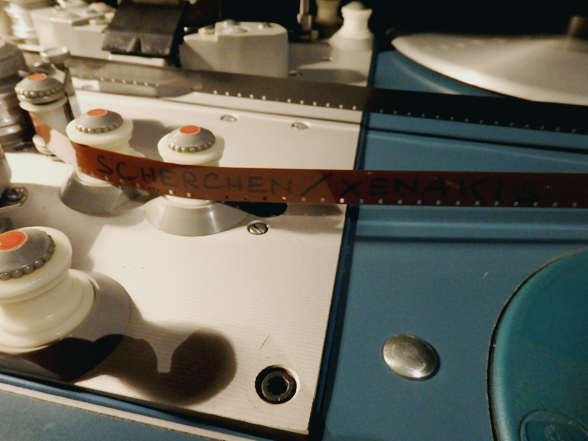
16mm Film und Magnettonband von Achorripsis © G. G. Karman
Hermann Scherchen, Achorripsis (1963)
Scherchens Achorripsis ist eine Klang-Lichtspiel-Studie über die gleichnamige Komposition von Iannis Xenakis. Als Ausgangsmaterial für den Film dient die in Scherchens Experimentalstudio Gravesano entwickelte rotierende Lautsprecherkugel (die sog. „atmende Kugel"), im Licht von vier Ultraviolett-Strahlern fotografiert. Der fünfminütige Film wurde bereits im Rahmen der 2011 von der Akademie der Künste organisierten Ausstellung „Iannis Xenakis. Kontrolle und Zufall“ gezeigt. KONTAKTE '15 präsentiert zum ersten Mal die restaurierte Fassung des Films mit der bisher verschollenen Tonspur und auf der großen Kinoleinwand.
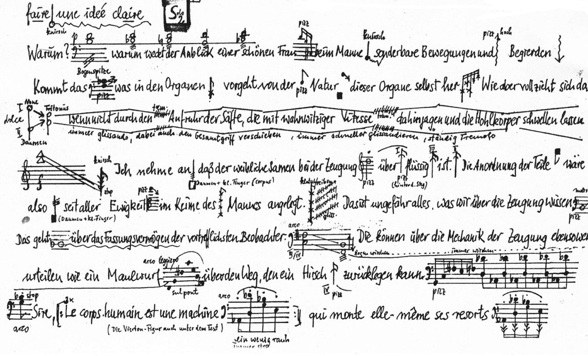
L’homme machine (Ausschnitt) © Georg Katzer
Georg Katzer, L’homme machine / Der Maschinenmensch (1998)
Dieses Solo für sprechenden Kontrabassisten entstammt Georg Katzers Kammeroper mit dem ausladenden Titel: "Einige Ansichten zum mechanischen Menschen, vorgetragen von Julien Offray de Lamettrie am 28. Oktober 1748 in Schloss Sanssouci im Beisein seiner Majestät des Königs in Preußen". (2000) Der französische, für die damalige Zeit erstaunlich moderne Querdenker musste aus seiner Heimat fliehen und fand Asyl bei König Friedrich II als Vorleser und Leibarzt. Seine Schrift "L´homme machine", voller absurder Hypothesen wie auch scharfsinniger Überlegungen, hat Katzer seit den 80ern zu mehreren Kompositionen angeregt. Für das Kontrabass-Solo, das noch vor der Oper entstand, hatte er Passagen aus dem Buch übersetzt und bearbeitet. Obwohl das Stück wie eine große Improvisation wirkt, ist es bis ins kleinste Detail ausnotiert. Lediglich die Live-Elektronik ist offen für eine Gestaltung ad hoc. Gregorio Garcia Karman hat für die Aufführung ein fein ausgearbeitetes Konzept erarbeitet.
(Georg Katzer, 2015)
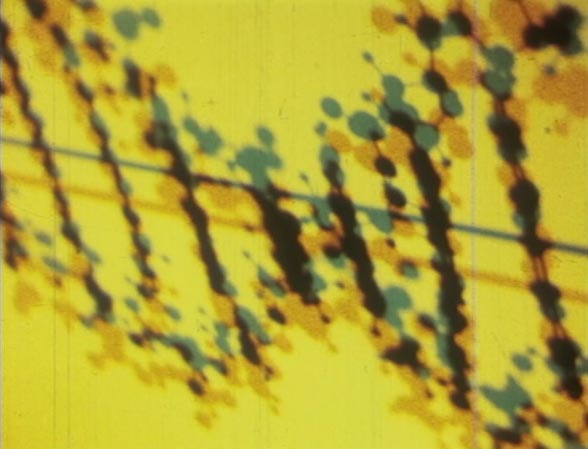
DNA in Reflection © Boye and Sarabai
Roberto Gerhard, DNA in Reflection (1963)
DNA in Reflection is an experimental film by Hans Boye and Anand Sarabai, two young researchers that met in the early 1960s at the MRC Laboratory of Molecular Biology of the University of Cambridge. The film shows the images of James D. Watson and Francis Creek’s double-helix DNA model (the key discovery for which the Nobel Prize of medicine was awarded to them in 1963) filmed through a kaleidoscope with a 16 mm camera.
Roberto Gerhard was approached by the two young scientists to compose music for the film. Gerhard, after viewing the film at the laboratory and overcoming some initial reluctance, agreed to produce the soundtrack in his home studio using the tape recorders. The resulting 8-minute “aleatoric soundtrack” was eventually made by the composer into an autonomous work under the name of Audiomobile No. 2 “DNA”. This piece was considered during Gerhard’s lifetime – quoting the program of a 1969 London festival – as the most famous British electronic music composition of its time.
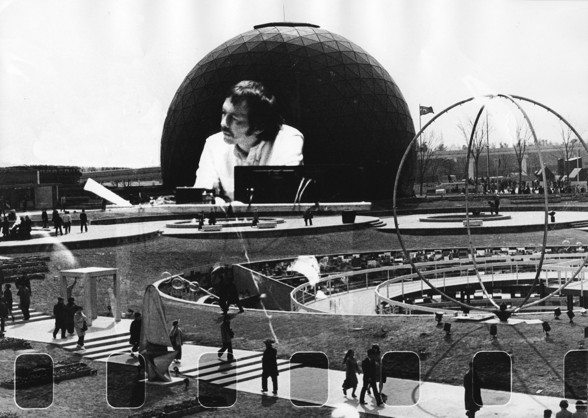
Erhard Grosskopf / DIALECTICS im Kugelauditorium der Expo’70 in Osaka (Fotomontage)
© Erhard Grosskopf
Erhard Grosskopf, DIALECTICS (1969/70)
DIALECTICS, Kompositionsauftrag für das deutsche Kugelauditorium bei der Expo’70, wurde in Osaka über eine 7-kanalige Wiedergabeanlage auf 50 Lautsprechergruppen verteilt, aufgeführt.
Das Material zu DIALECTICS besteht aus synthetischen Klängen, aus elektronisch verarbeiteten Instrumentalklängen, aus Sprache und aus Klängen von drei dazu gespielten Instrumenten: Flöte oder Violine - Klarinette oder Viola - Posaune oder Kontrabass. Daraus ergeben sich 8 mögliche Versionen.
Es ist schließlich möglich, das Werk im Studio zu realisieren und später nur über Lautsprecher abzuspielen. Für die Aufzeichnung wäre ein Siebenspurband erforderlich. Für die Osaka-Siebenspurversion habe ich die elektronischen Klänge im Studio der Universität Utrecht, die Aufnahmen der Instrumente beim Saarländischen Rundfunk in Saarbrücken produziert.
Als Sprachmaterial wurde der folgende Satz verwendet, den ich nach Texten aus „Dialectics of Liberation“ von Stokely Carmichael geformt habe: „They donate freedom – it means nothing – what they should do is refrain from oppression.“
(Erhard Grosskopf, 1970)
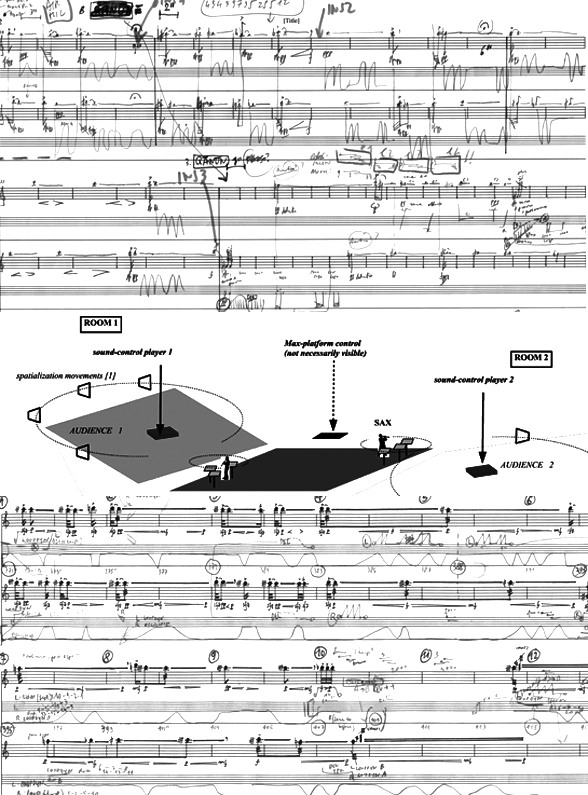 Skizzen zu Ephemeris © Valerio Sannicandro
Skizzen zu Ephemeris © Valerio Sannicandro
Valerio Sannicandro, Ephemeris – Ekleipsis (2015, UA)
Ephemeris / / Ekleipsis
This diptych composition is a work conceived in the first part for two high instruments (clarinet, soprano sax) and in the second for contrabass clarinet and baritone saxophone. A clear opposition is made: bright – dark, moving – static, ephemeral – telluric, willing to explore two very different territories (and moods).
The first part, Ephemeris, is at the same time a study [Studie] on spatialization, perception of multiple spaces and follows a personal research (on sound projection) that was started in 2003 with different techniques and technologies. This tendency (of constructing sounds according different criteria then harmonic or discursive ones) can be called Sound Architecture: here we have an exploration of spatial behaviors where sounds – essentially blocks of several densities – focus on almost the same pitches but with various movements and dynamics. The second, Ekleipsis, is a constantly moving, highly dense piece for two very low instruments representing a definite contrast with the preceding one.
Context / Thoughts
It seems to me that when mankind looks above, in the infinity of sky, feels naturally as one unshared entity regardless of cultural, anthropological or social boundaries. Mediterranean cultures show this at the best if we just look at some words common in almost all Western languages. The number zero, for instance, comes from zephyrus, the light west-wind (surprisingly enough both in islamic sifr and sanskrit shoonya the onomatopoetic sound “s” gives an impression of wind). The old question whether zero is a number or not, whether the non-existence can be embodied or not, finds a naturalistic answer in the wind that is, together with very low-tech NASA-sounds, a central sonic element in this composition. At the beginning and at the end of Ephemeris, arabic and sanskrit numbers are spoken inside the wind instruments (these are conceived primarily to produce complex sounds because not immediately understandable).
Music / Sound
Here is the sound (with its scattering color nuances and tiny timbre variations) to lead a discourse, not melodies or harmonies. Indeed the all discourse is based on few pitches that are organized more geometrico: according their placement and movement along a complex series of trajectories, so that the main protagonist of Ephemeris is the spatial situation, and the resulting sound quality.
Listening
Therefore, the experience of listening is the main content of this work (that belong to a series of so-called “spatial pieces” [Raumstücke] that I am composing since a few years). Between concert piece and sound installation, the aim is to listen at this very unique environment (two adjacent spaces) were sound objects would move around. We may perceive them, conscientiously or not, and build relations between foreground and background sonic events. Moreover, the concept of sound osmosis (sounds from the first hall is coming into the second and affecting the general perception) is a main factor in the composition of the work.
Composer's notes
As in each compositional work, I tend to explore acoustic situations whose exact result, in spite it is exactly notated, is impossible to know beforehand. They are amplified by the power of very natural-sounding live-electronic (effects are producing or reproducing phenomena like echoes, reverberation, etc.), are developed in a series of possibilities, sometimes very complex. In particular it is the question of sound-projection that focuses my attention. Musicians indeed are projecting in a variable way their instrumental sound (moving toward two directions – two microphones) a movement that affects the spatial result.
But also the use of the instruments themselves as a microscopic “resonance room” (using a very close microphone capturing wind and vocal sounds inside the instrument) is explored in various ways, so that extremely ephemeral sounds can be projected and perceived.
(Valerio Sannicandro, 2015)